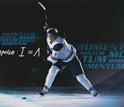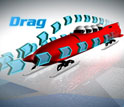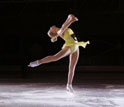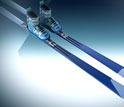News Release 09-233
National Science Foundation and NBC Learn Help Students Discover "The Science of the Olympic Winter Games"
Online videos explain the science behind winning gold at the 2010 Vancouver Olympic Games
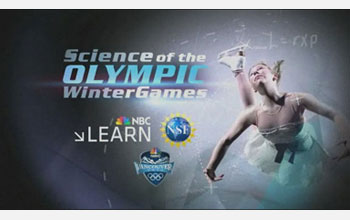
Video series focuses on how athletes skate, ski, jump and curl their way to Olympic gold.
December 9, 2009
View a video on the physics of the hockey slapshot.
This material is available primarily for archival purposes. Telephone numbers or other contact information may be out of date; please see current contact information at media contacts.
Science and sport. Have you ever wondered ...
- How angular momentum helps one of the world's top ranked figure skaters Rachael Flatt achieve the perfect triple toe loop?
- How elastic collision allows three-time Olympic hockey player Julie Chu convert a game-winning slapshot?
- Or how Newton's Three Laws of Motion propel U.S. Olympic Trials silver medalist and short track speed skater J.R. Celski to the finish line?
These are just a few of the scientific principles explored in a new, fast-moving, 16-part, video series for students and adults entitled "The Science of the Olympic Winter Games," presented by project partners NBC Learn, NBC Olympics and the National Science Foundation (NSF).
"The Science of the Olympic Winter Games" focuses on the science behind how athletes skate, ski, jump and curl their way to winter Olympic gold. This groundbreaking series capitalizes on next February's Vancouver Olympics to make science understandable to students by illustrating how it applies to competitive sports.
The video series is narrated by NBC News anchor Lester Holt and available to viewers on http://www.NBCOlympics.com/science, http://www.nbclearn.com/ and http://www.nsf.gov/news/special_reports/olympics/. NBC's "Today" premiered a segment from the series this morning. The project will also be offered to educators as a timely way to incorporate the Olympics into classroom learning.
Each video in the series shows NSF-supported scientists explaining scientific principles while Olympic athletes describe how these principles apply to their respective sports.
"Science touches every aspect of our nation's popular pursuits, including its athletic events," said Jeff Nesbit, director of NSF's Office of Legislative and Public Affairs. "It's exciting to partner with NBC Learn and NBC's Emmy-award winning Olympic division to present the range and depth of that science to a huge American audience while ultimately inspiring the passions of young people across the United States in all the things science can do."
A state-of-the-art, high-speed camera with an astonishing ability to capture images at rates of up to 1,500 frames per second follows the movements of the athletes frame-by-frame providing illustrations of Newton's Three Laws of Motion, the Law of Conservation of Angular Momentum, friction, drag, speed, velocity and other scientific concepts.
"This unique project shows just how versatile NBC Learn can be," said Steve Capus, president of NBC News. "We've made a commitment to education and this project is another creative way to support classroom learning using the journalism and production resources of NBC News. Every two years the Olympics captivate us. This project is another way of telling the remarkable stories of athletes who are the best of the best."
Rachael Flatt, a 17-year-old high school senior at Cheyenne Mountain High School. in Colorado Springs, Colorado, and among the favorites to qualify for the Vancouver Games in figure skating, may understand the ins-and-outs of the science behind her sport better than anyone else on the ice. The straight-A student's father is a biochemical engineer, while her mother is a molecular biologist.
"I guess it's definitely safe to say that science runs in my blood!" said Flatt. "I jumped at the chance to participate in this project because my parents have passed along their love of science to me over the years and I hope to one day pursue a career in the field."
In addition to Flatt, the "The Science of the Olympic Winter Games" features two-time Olympic medalist and Harvard graduate Julie Chu (Hockey) from Fairfield, Connecticut; 2006 Olympic bronze medalist John Shuster (Curling), Chisholm, Minnesota; 2006 Olympian Emily Cook (Freestyle Skiing), from Belmont, Massachusetts; and 2010 Olympic hopefuls J.R. Celski (Short Track Speed Skating) from Federal Way, Washington and Liz Stephens (Cross-Country Skiing) from East Montpelier, Vermont.
-NSF-
-
View Video
More than just a physical game, hockey is a showcase for physics on ice.
Credit and Larger Version -
In episode 11, Banking on Speed, researchers explain how drag impacts U.S. chances to win gold.
Credit and Larger Version -
Olympic hopeful Rachael Flatt helps an NSF-sponsored researcher explain a skater's rotation.
Credit and Larger Version -
In skiing events, it's often the skis and materials used to make them that give athletes an edge.
Credit and Larger Version
About NBC Learn
NBC Learn is the educational arm of NBC News dedicated to providing resources for students, teachers, and lifelong learners. The online resources NBC Learn has created for the education community leverages nearly 80 years of historic news coverage, documentary materials, and current news broadcasts. Currently two unique offerings, iCue and NBC News Archives on Demand, give students and teachers access to thousands of video clips from the NBC News archives, including great historic moments--from the Great Depression to the Space Race to the latest political coverage. NBC Learn also offers primary source materials, lesson plans and classroom planning resources, and additional text and image resources from our content partners.
About NBC Olympics
NBC, America's Olympic Network, has broadcast 11 Olympic Games, the most Olympics broadcast by any network. NBC surpassed ABC's 10 Olympics with the 2008 Beijing Games, the most watched event in U.S. television history with 215 million viewers.
The 2010 Vancouver Games mark the sixth of an unprecedented seven consecutive Olympic broadcasts by NBC Sports, which began with the 2000 Sydney Games and continues through the 2012 London Games.
About the National Science Foundation
The National Science Foundation is an independent federal agency that supports fundamental research and education across all fields of science and engineering. In fiscal year 2009, its budget is $9.5 billion, which includes $3.0 billion provided through the American Recovery and Reinvestment Act. NSF funds reach all 50 states through grants to over 1,900 universities and institutions.
The Science of the Olympic Winter Games Episodes
View the complete video series, "The Science of the Olympic Winter Games," and learn about the physics, mechanics, materials and engineering behind the athletes and the equipment of the 2010 Vancouver Winter Olympics.and learn about the physics, mechanics, materials and engineering behind the athletes and the equipment of the 2010 Vancouver Winter Olympics.
1) Aerial Physics (Aerial Skiing)
In the sport of freestyle aerials, skiers are judged on their ability to perform complex jumps in the air. Emily Cook, a 12-year veteran of the U.S. Freestyle team, and Paul Doherty, a senior scientist at the Exploratorium in San Francisco, show how these jumps actually come from three basic twisting techniques that you can try in your own classroom.
2) Slapshot Physics (Hockey)
One of the most popular team sports in the Winter Olympics is hockey. More than just a physical game, for scientists it's a showcase for physics on ice - especially when it comes to the slapshot. Three-time Olympian Julie Chu, Thomas Humphrey, a senior scientist at the Exploratorium in San Francisco, and Katharine Flores, an Associate professor in the department of materials science and engineering at Ohio State University, break down the science of hockey's hardest shot.
3) Internal Athlete (Cross-Country Skiing)
The United States hasn't won an Olympic medal in cross-country skiing since 1976, but in 2010, several skiers hope to change that. If they're successful, you can be certain it's due to their incredible endurance--cross-country skiers are among the fittest athletes in the world. Deborah King, an Associate professor in the department of exercise and sports sciences at Ithaca College and Joseph Francisco, president of the American Chemical Society, look at the biochemistry of human endurance.
4) Olympic Motion (Mixed Sports)
The Olympics are a unique chance to marvel at the physical abilities of these world-class athletes. But what makes them unique? After all, they're made of the same flesh and blood as the rest of us--how did they become Olympians? Dan Fletcher, an Associate professor in the department of bioengineering at UC Berkeley, has some answers.
5) Competition Suits (Mixed Sports)
Olympic athletes have long worn special competition clothing to gain an edge. Science and technology continue to improve on what they wear. Hear from Olympians Chad Hedrick, Steve Holcomb and Erin Hamlin, and Melissa Hines, the director of the Cornell University Center for Materials Research, about how the latest in competition suits will go to work for Team USA in Vancouver.
6) Mathletes (Mixed Sports)
It's been called "the Queen of Sciences"--mathematics. It might not be as obvious in Olympic sports as physics or materials engineering, but math--from simple arithmetic to calculus--is part of every jump, every spin, every move the athletes make on snow or ice. Mathematician Edward Burger from Williams College explains why math counts.
7) The Science of Skis
In skiing events like the downhill, slalom or ski jump it's often the skis that are bound to an athlete's feet--and the materials used to make them--that give these athletes an edge over the competition. U.S. Ski Team members Julia Mancuso, Ted Ligety and Scott Macartney, and Katharine Flores, an Associate professor in the department of materials science and engineering at Ohio State University, explain how the materials used to make skis play a vital role in their performance on the mountain.
8) The Science of Skates
The ice skates worn by this year's hockey players, figure skaters and speed skaters are vastly different from what were once used. Melissa Hines, the director of the Cornell University Center for Materials Research, and Sam Colbeck, a retired scientist from the U.S. Army Cold Regions Lab, explain how innovations in boot and blade design help skaters perform better than ever before.
9) Figuring Out Figure Skating
Every four years, we watch the stakes for Olympic figure skaters get higher, as they try to increase rotation in the air with their triple axels and quadruple toe loops. How do they do that? It's a scientific principle that we asked Olympic hopeful Rachael Flatt and Deborah King, an Associate professor in the department of exercise and sports sciences at Ithaca College, to help explain.
10) Safety Gear (Mixed Sports)
As athletes push themselves to their limits and sometimes crash or collide, they rely on protective gear to keep them safe. NSF-funded scientists Katharine Flores, an Associate professor in the department of materials science and engineering at Ohio State University and Melissa Hines, director of the Cornell University Center for Materials Research, explain the physics of a collision and exactly how this gear, especially safety helmets, works to prevent injury.
11) Banking on Speed (Bobsled)
The winter games in Vancouver provide a chance for the United States' four-man bobsled team to win its first gold medal in more than 60 years. And with the help of Paul Doherty, senior scientist at the Exploratorium in San Francisco, Deborah King, Associate professor in the department of exercise and sports sciences at Ithaca College, physicist George Tuthill of Plymouth State University, and bobsled designer Bob Cuneo, the team explains how they hope to accomplish this feat.
12) Downhill Science (Alpine Skiing)
In February, Olympic skiers such as Julia Mancuso, Ted Ligety, Marco Sullivan and Scott Macartney will race down Vancouver's Whistler Mountain at speeds of up to 90 miles an hour. Paul Doherty, senior scientist at the Exploratorium in San Francisco, and Sam Colbeck, a retired scientist from the U.S. Army Cold Regions lab, explain the physics of this downhill thrill ride.
13) Air Lift (Ski Jump)
This year, the U.S. team is a serious medal contender in Nordic Combined, a sport that combines ski jumping with cross-country skiing. U.S. hopefuls Todd Lodwick and Bill Demong, along with NSF-funded scientists Paul Doherty, senior scientist at the Exploratorium in San Francisco, and physicist George Tuthill of Plymouth State University, explain the principles of physics that are used to get high scores in the long jumps.
14) Science of Snowboarding
The stakes are high for the snowboarders in Vancouver, as they try to master new tricks to unseat the star of Torino, American Shaun White. But to get "max air" off the half-pipe without losing their balance, they might want to check out this experiment that Paul Doherty, a senior scientist at the Exploratorium in San Francisco, cooked up, using a skateboard and a glass of water.
15) Science Friction (Curling)
Curling has been in the Winter Olympics for four years now, but it still seems a little strange to most of us. John Shuster, the captain--or "skip"--of the U.S. Curling Team in Vancouver, explains this unusual sport, and NSF-funded scientists Sam Colbeck, a retired scientist from the U.S. Army Cold Regions Lab and physicist George Tuthill of Plymouth State University explain the friction that makes it all work.
16) Blade Runners (Short Track Speed Skating)
The U.S. speed skating team has two best hopes against a powerful South Korean team that took three of a possible four golds in Torino: Apolo Ohno and J.R. Celski--an 18-year-old World Champion in his first Olympics. Speed skating is all about force and movement--what, in physics, are known as Newton's First Three Laws of Motion. Celski and physicist George Tuthill, of Plymouth State University, explain.
Media Contacts
Bobbie Mixon, NSF, (703) 292-8070, email: bmixon@nsf.gov
Lauren Skowronski, NBC News, (212) 664-2432, email: Lauren.Skowronski@nbcuni.com
Adam Freifeld, NBC Sports and Olympics, (212) 664-6772, email: Adam.Freifeld@nbcuni.com
Program Contacts
Susan M. Mason, NSF, (703) 292-7748, email: smason@nsf.gov
The U.S. National Science Foundation propels the nation forward by advancing fundamental research in all fields of science and engineering. NSF supports research and people by providing facilities, instruments and funding to support their ingenuity and sustain the U.S. as a global leader in research and innovation. With a fiscal year 2023 budget of $9.5 billion, NSF funds reach all 50 states through grants to nearly 2,000 colleges, universities and institutions. Each year, NSF receives more than 40,000 competitive proposals and makes about 11,000 new awards. Those awards include support for cooperative research with industry, Arctic and Antarctic research and operations, and U.S. participation in international scientific efforts.
Connect with us online
NSF website: nsf.gov
NSF News: nsf.gov/news
For News Media: nsf.gov/news/newsroom
Statistics: nsf.gov/statistics/
Awards database: nsf.gov/awardsearch/
Follow us on social
Twitter: twitter.com/NSF
Facebook: facebook.com/US.NSF
Instagram: instagram.com/nsfgov



